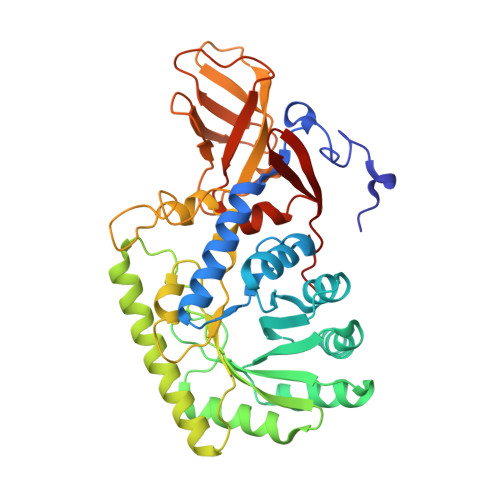Marine Proteobacteria metabolize glycolate via the beta-hydroxyaspartate cycle.
Schada von Borzyskowski, L., Severi, F., Kruger, K., Hermann, L., Gilardet, A., Sippel, F., Pommerenke, B., Claus, P., Cortina, N.S., Glatter, T., Zauner, S., Zarzycki, J., Fuchs, B.M., Bremer, E., Maier, U.G., Amann, R.I., Erb, T.J.(2019) Nature 575: 500-504
- PubMed: 31723261
- DOI: https://doi.org/10.1038/s41586-019-1748-4
- Primary Citation of Related Structures:
6QKB, 6RQA - PubMed Abstract:
One of the most abundant sources of organic carbon in the ocean is glycolate, the secretion of which by marine phytoplankton results in an estimated annual flux of one petagram of glycolate in marine environments 1 . Although it is generally accepted that glycolate is oxidized to glyoxylate by marine bacteria 2-4 , the further fate of this C 2 metabolite is not well understood. Here we show that ubiquitous marine Proteobacteria are able to assimilate glyoxylate via the β-hydroxyaspartate cycle (BHAC) that was originally proposed 56 years ago 5 . We elucidate the biochemistry of the BHAC and describe the structure of its key enzymes, including a previously unknown primary imine reductase. Overall, the BHAC enables the direct production of oxaloacetate from glyoxylate through only four enzymatic steps, representing-to our knowledge-the most efficient glyoxylate assimilation route described to date. Analysis of marine metagenomes shows that the BHAC is globally distributed and on average 20-fold more abundant than the glycerate pathway, the only other known pathway for net glyoxylate assimilation. In a field study of a phytoplankton bloom, we show that glycolate is present in high nanomolar concentrations and taken up by prokaryotes at rates that allow a full turnover of the glycolate pool within one week. During the bloom, genes that encode BHAC key enzymes are present in up to 1.5% of the bacterial community and actively transcribed, supporting the role of the BHAC in glycolate assimilation and suggesting a previously undescribed trophic interaction between autotrophic phytoplankton and heterotrophic bacterioplankton.
Organizational Affiliation:
Department of Biochemistry & Synthetic Metabolism, Max Planck Institute for Terrestrial Microbiology, Marburg, Germany. schada@mpi-marburg.mpg.de.
















